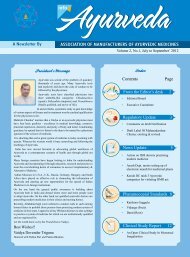Wishing You Happy Dhanwantari Jayanti Happy Diwali & A ...
Wishing You Happy Dhanwantari Jayanti Happy Diwali & A ...
Wishing You Happy Dhanwantari Jayanti Happy Diwali & A ...
You also want an ePaper? Increase the reach of your titles
YUMPU automatically turns print PDFs into web optimized ePapers that Google loves.
Standards for Ayurvedic Formulation and<br />
Raw Materials<br />
In continuation to our series of information in our last issue of newsletter, we are once again sharing the Pharmacopoeial Standards of yet another formulation called<br />
Ashokarishta from AFI part II. We are also including a few herbs with its standards as per API, being used as a raw material in the manufacturing of Ashokarishta for<br />
the benefit of Ayurvedic Industry.<br />
It is advised that one should test both the raw material & finished product as per the standard test procedure mentioned in the respective pharmacopoeia.<br />
Please do record the data and in case you find any discrepancy in the multiple lots/batches than please share the same either with the Ayurvedic Pharmacopoeia<br />
Committee or with AMAM.<br />
Given below are the standards for Ashokarishta & its few herbs. We are certain that this piece of information will be useful & welcomed by research scientists &<br />
ayurvedic manufacturing units.<br />
ASOKARISHTA<br />
(AFI Part-I page 46)<br />
+ÉÉäEòºªÉ iÉÖ±ÉɨÉäEòÉ\SÉiÉÖpùÉæhÉä VɱÉä {ÉSÉäiÉÂ*<br />
{ÉÉnùÉä¹Éä ®úºÉä {ÉÚiÉä ÉÒiÉä {ɱÉÉiÉuùªÉ¨É **114**<br />
nùtÉnÂù MÉÖb÷ºªÉ vÉÉiÉCªÉÉ: {ɱɹÉÉäb÷ÊÉEÆò ¨ÉiɨÉÂ*<br />
+VÉÉVÉÒ ¨ÉÖºiÉEÆò ÉÖh`öÓ nùÉ´ªÉÖÇi{ɱɡò±ÉÊjÉEò¨É **115**<br />
+É©ÉÉκlÉ VÉÒ®úEÆò ´ÉɺÉÉÆ SÉxnùxÉ\SÉ Ê´ÉÊxÉÊIÉ{ÉäiÉÂ*<br />
SÉÚhÉÇʪÉi´ÉÉ {ɱÉÉÆÉäxÉ iÉiÉÉä ¦ÉÉhbä÷ ÊxÉvÉÉ{ɪÉäiÉ **116**<br />
¨ÉɺÉÉnÚùnÂùv´ÉÇ\SÉ {ÉÒi´ÉèxɨɺÉÞMnù®ú¯ûVÉÉÆ VɪÉäiÉ *<br />
V´É®ú\SÉ ®úHòÊ{ÉkÉÉÉÉæ ¨ÉxnùÉÎMxÉi´É¨É®úÉäSÉEò¨ÉÂ**<br />
¨Éä½þÉÉälÉɯûÊSɽþ®úºi´ÉÉÉäEòÉÊ®ú¹]õºÉÆÊYÉiÉ&**117**<br />
English : Asok Tree<br />
Gujrati : Ashoka<br />
Hindi : Ashoka<br />
Kannada : Ashokadamara, Ashokamara, Kankalimara<br />
Kashmiri : Ashok<br />
Malayalam : Asokam<br />
Marathi : Ashok<br />
Oriya : Ashoka<br />
Punjabi : Asok<br />
Tamil : Asogam, Asogu, Asokam<br />
Telugu : Ashokapatta<br />
DESCRIPTION<br />
(¦Éè¹ÉVªÉ®úixÉɴɱÉÒ,ºjÉÒ®úÉäMÉÉÊvÉEòÉ®ú 114-117)<br />
1. Ashoka (St.Bk.) 4.800 kg<br />
2. Water for decoction 49.152 l reduced to 12.288 l<br />
3. Guda 9.600 kg<br />
Prakshepa Dravyas<br />
4. Dhataki (Fl.) 768 g<br />
5. Ajaji (Shveta jiraka) (Fr.) 48 g<br />
6. Mustaka (Musta) (Rz.) 48 g<br />
7. Shunthi (Rz.) 48 g<br />
8. Darvi (Daruharidra) (St.) 48 g<br />
9. Utpala (Fl.) 48 g<br />
10. Haritaki (P.) 48 g<br />
11. Bibhitaka (P.) 48 g<br />
12. Amalaki (P.) 48 g<br />
13. Amrasthi (Amra) (Enm.) 48 g<br />
14. Jiraka (Shveta jiraka) (Fr.) 48 g<br />
15. Vasa (Rt.) 48 g<br />
16. Candana (Shveta candana) (Ht.Wd.) 48 g<br />
Dose: 12 to 24 ml<br />
Important Therapeutic Uses: Asrigdara Ruja (Dysmenorrhoea),<br />
Yoniruja (Vaginal Pain), Shveta Pradara (Leucorrhoea), Jvara (Fever),<br />
Raktapitta (Bleeding disorder), Arsha (Haemorrhoids), Mandaagni<br />
(Impaired digestive fire), Arocaka (Tastelessness), Meha (Excessive flow<br />
of urine), Shotha (Inflammation)<br />
SYNONYMS<br />
Sanskrit : Kankeli<br />
Assamese : Ashoka<br />
Bengali : Ashoka<br />
Main ingredients of Ashokarishta<br />
ASHOKA (Stem bark)<br />
Ashoka consists of dried stem bark of Saraca<br />
asoca (Rose.) De. Willd, Syn. Saraca indica<br />
Linn. (Fam. Leguminosae), collected in spring<br />
from mature, wild or cultivated trees, found in<br />
Central and Eastern Himalayas, Western Ghats<br />
and Deccan.<br />
a) Macroscopic<br />
Bark channelled, externally dark green to greenish grey, smooth with<br />
circular lenticels and transversely ridged, sometimes cracked, internally<br />
reddish-brown with fine longitudinal strands and fibers, fracture splintery<br />
exposing striated surface, a thin whitish continuous layer is seen beneath<br />
the cork layer, taste, astringent.<br />
b) Microscopic<br />
Transverse section of stem bark shows periderm consisting of a wide layer<br />
of cork, radially flattened, narrow cork cambium, secondary cortex wide<br />
with one or two continuous layers of stone cells with many patches of<br />
sclereids, parenchymatous tissue contains yellow masses and prismatic<br />
crystals: secondary phloem consists of phloem parenchyma, sieve tubes<br />
with companion cells and phloem fibres occuring in groups, crystal fibres<br />
present.<br />
IDENTITY, PURITY AND STRENGTH<br />
Foreign matter: Not more than 2 per cent,<br />
Total Ash: Not more than 11 per cent,<br />
Acid-insoluble ash: Not more than 1 per cent,<br />
Alcohol (90 per cent) soluble extractive: Not less than 15 per cent,<br />
Water-soluble extractive: Not less than 11 per cent<br />
CONSTITUENTS<br />
Tannins and a crystalline glycosides.<br />
PROPERTIES AND ACTION<br />
Rasa: Kashaya, Tikta<br />
Guna : Laghu, Ruksha<br />
Veerya : Sheeta<br />
Vipaka : Katu<br />
Karma: Grahi, Varnya, Hridya, Shothahara, Vishaghna<br />
IMPORTANT FORMULATIONS -<br />
Ashokarishta, Ashokaghrita<br />
THERAPEUTIC USES -<br />
Asrigdara, Apaci, Daha, Raktadosha, Shotha<br />
DOSE 20-30 g of the drug for decoction.<br />
www.amam-ayurveda.org 6




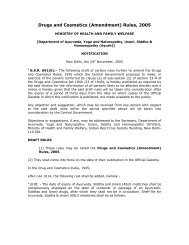
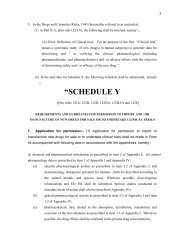
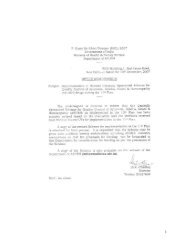

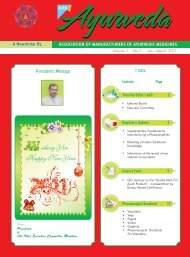

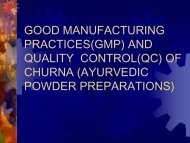
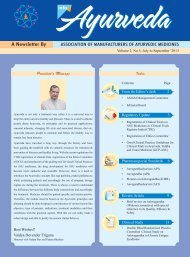
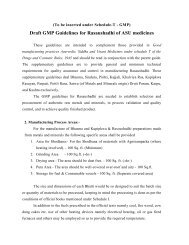
![[To be published in Gazette of India Part II Section 3, sub-section iii]](https://img.yumpu.com/28570283/1/190x245/to-be-published-in-gazette-of-india-part-ii-section-3-sub-section-iii.jpg?quality=85)

